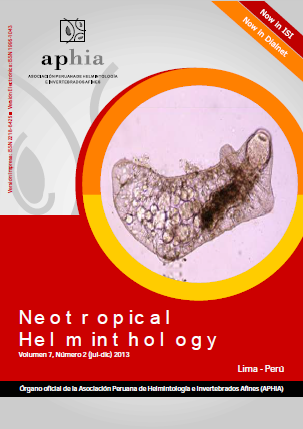TOXICITY OF AGAVE AMERICANAAND FURCRAEA ANDINA (ASPARAGACEAE) ON CULEX QUINQUEFASCIATUS (DIPTERA) AND HELEOBIA CUMINGII (MOLLUSCA)
DOI:
https://doi.org/10.24039/rnh201372988Keywords:
Culex, ecotoxicology, Heleobia, toxicity, toxicity assay.Abstract
Agave americana L. and Furcraea andina Trel. (Asparagaceae), are important species for search of new pesticide agents. The dipteran Culex quinquefasciatus is common in aquatic environments of Lima and causes painful stings in people. The gastropod Heleobia cumingii D'Orbigny, 1835 (Cochliopidae) is a native snail found in lotic and lentic aquatic environments of Peru. Thus, the aim of this study was to evaluate the effect of the insecticide and molluscicide of dry leaves powder and juice in aqueous of A. americana and F. andina on C. quinquefasciatus and H. cumingii. The end point was the mortality of the larvae of C. quinquefasciatus and of the snail H. cumingii. Bark of F. andina showed higher insecticidal effect in relation to other aqueous extracts in toto and periderm evaluated in both plant species. The extract in toto of A. americana showed a greater effect molluscicide in relation to the rest of aqueous aqueous extracts of bark and periderm evaluated in both plant species. Aqueous extracts of dry powder of A. americana and F. andina had higher insecticides than molluscicidal effects. Instead, the aqueous extracts juice from A. americana and F. andina showed greater molluscicides effects than insecticides.
Downloads
Published
How to Cite
Issue
Section
License
Copyright (c) 2021 Neotropical Helminthology

This work is licensed under a Creative Commons Attribution-NonCommercial-NoDerivatives 4.0 International License.
OBJETO: El AUTOR-CEDENTE transfiere de manera TOTAL Y SIN LIMITACIÓN alguna al CESIONARIO los derechos patrimoniales que le corresponden sobre la (s) obra(s) tituladas: xxxxxxxxxxxxxxxx, por el tiempo que establezca la ley internacional. En virtud de lo anterior, se entiende que el CESIONARIO adquiere el derecho de reproducción en todas sus modalidades, incluso para inclusión audiovisual; el derecho de transformación o adaptación, comunicación pública, traducción, distribución y, en general, cualquier tipo de explotación que de las obras se pueda realizar por cualquier medio conocido o por conocer en el territorio nacional o internacional.
REMUNERACIÓN: La cesión de los derechos patrimoniales de autor que mediante este contrato se hace será a título gratuito.
CONDICIONES Y LEGITIMIDAD DE LOS DERECHOS: El AUTOR-CEDENTE garantiza que es propietario integral de los derechos de explotación de la(s) obra(s) y en consecuencia garantiza que puede contratar y transferir los derechos aquí cedidos sin ningún tipo de limitación por no tener ningún tipo de gravamen, limitación o disposición. En todo caso, responderá por cualquier reclamo que en materia de derecho de autor se pueda presentar, exonerando de cualquier responsabilidad al CESIONARIO.
LICENCIA DE ACCESO ABIERTO: El AUTOR-CEDENTE autoriza que manuscrito publicado en La Revista Neotropical Helminthology permanece disponible para su consulta pública en el sitio web https://www.neotropicalhelminthology.com/ y en los diferentes sistemas de indexación y bases de datos en las que la revista tiene visibilidad, bajo la licencia Creative Commons, en la modalidad Reconocimiento-No comercial- Sin Trabajos derivados –aprobada en Perú, y por lo tanto son de acceso abierto. De ahí que los autores dan, sin derecho a retribución económica, a la Asociación Peruana de Helmintología e Invertebrados Afines (APHIA), los derechos de autor para la edición y reproducción a través de diferentes medios de difusión.


 Numero 2 Volumen 19 - 2025 (versión Anticipada)
Numero 2 Volumen 19 - 2025 (versión Anticipada)














































